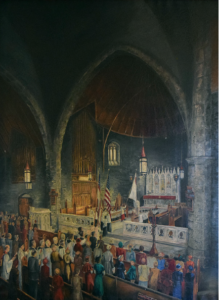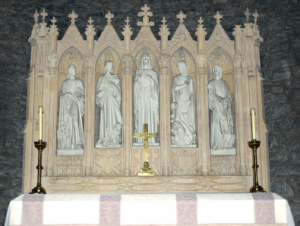A view of Saint John’s Episcopal Church in 1950

Defining Regionalism
Charles Ford McCall’s painting of a 1950 Whitsunday service shows the influence of regionalism, an artistic movement that emerged in the United States in the 1920s and 30s. In that period, two major factors would alter the face of American art. One was the increasing presence of the European avant garde, as many of Europe’s leading artists fled to the West as fascism was spreading over the continent. The other factor was that America’s artists would be given federal commissions on a scale previously unheard of in the US during the 1930s through the Works Progress Administration, a program initiated to provide Ameri-cans with the opportunity to work during the Great Depression. Through the WPA, artists were tasked with commissions to paint large, public murals—works of art with a patriotic and civic purpose, in-tended to characterize the national identity and to represent the nation’s history, folk culture, as well as industry and agriculture. It was through these WPA commissions that regionalism, a movement characterized by romantic nationalism and celebration of the spirit of the American people, was transmitted to the public and found mass appeal.
American artists in this period felt the pressure to compete with their newly arrived European counter-parts in the pursuit of formal innovation so fundamental to modernist art. At the same time, there was a simultaneous need to manifest something of their own identity as American artists in contrast to the Europeans. Some regionalists rejected modernism with great ardor while others adapted its abstract tendencies to a realist mode of description, but in either case, the styles they developed reflect the drive to develop a uniquely American vernacular. The solution would place a pointed emphasis on popular accessibility. The sort of license taken by such Euro-pean modernists as Matisse and Picasso in rendering form was arguably a factor in the approaches taken by many regionalists, who exaggerated and manipulated the objectivity of their representations for the sake of pictorial impact, but the regionalist impulse was reined by a desire to communicate with the widest possible audience.
To these ends, regionalists developed formal styles which referenced the tradition of fine art in the United States—romantic yet pragmatic and unpretentious—as well as more common and popular forms, such as illustration. Regionalist work is meant to appear simple and genuine, rather than polished and academic.
Regionalism in Youngstown
Regionalists emphasized rural or small-town themes and imagery, rejecting the metropolis and its associations with increasingly abstract and esoteric forms of modernist art. Likewise, many of the artists did not feel compelled to live and work in New York as artists so often do, but rather were more inclined to inhabit small towns in the Midwest, where they might work to typify and pay homage to the culture of a particular region (hence the name regionalism.)
One may discern in McCall’s picture traces of the style and sensibility of Youngstown’s local regionalist master Clyde Singer. Singer, who was born nearby in Malvern in 1908, began his professional life as a sign painter. Using his earnings from this early vocation, Singer would attend the Columbus Museum of Art School and then the Art Students League in New York, where he learned from leading regionalist painters such as Thomas Hart Benton and Kenneth Hayes Miller. After completing his studies in New York, Singer settled in Youngstown in the 1940s, where he became a long-standing fixture in the artistic culture of Youngstown, not only for his paintings but also as director of the Butler Institute of American Art and as weekly arts columnist for the Vindicator.
McCall was born in Chattanooga in 1889. He moved to Ohio in 1917, residing in Poland and working as a realtor. A self-taught artist, he took up painting in 1941, participating regularly in exhibitions throughout the 1940s and 50s, including a number of shows at the Butler. Perhaps his most renowned painting, “The Great Blondin Crosses Federal Street,” a historical scene depicting the 19th century tightrope walker’s performance downtown, won first prize in the 1948 Area Artist’s show and was exhibited at the National Academy and the Carnegie Museum. It is currently in the collection of the Butler. Another of his paintings, “God’s Day,” in the collection of the Pennsylvania Academy of Fine Arts, reflects his penchant for painting the Amish of Ohio and Pennsylvania. McCall, though a member of Indianola Methodist Church, painted “Whitsunday” as a gift to Saint John’s.
Saint John’s Then & Now
McCall happened to have produced his picture at a very opportune moment, as the church was just on the verge of a series of major renovations which would occur in the following years. The painting offers many details of interest relating to the church and its various monuments, many of which came to grace our church after McCall’s picture was completed.

One such example is the view of the empty Reredos, which today hold statues of Christ and the four Apostles of the Gospels. The sculptures were installed and dedicated on January 13, 1952. Designed by John Angel and sculpted in Italy, these statues were commissioned in memory of Reverend William Kinder, who served as Rector of Saint John’s from 1942 until his death in 1949. Reverend Kinder was followed in his role by Reverend Burt. Young Reverend Burt, who was still in his first month as rector of the church on Whitsunday of 1950 is seen at the end of the procession along the left edge of the painting.
McCall’s picture also gives us a view of one of the original white chancel windows, which in July 1951 were replaced with stained glass representations of Isaiah, Jeremiah, Hosea, and Amos. The church’s clerestory windows, which were later installed in 1955 and which commemorate parishioners involved in the local steel industry, may also be said to bear the influence of regionalism, both in form and content.
In addition to the windows and sculptures, other alterations to the décor of the church are evidenced in McCall’s picture. The interior of Saint John’s under-went a massive renovation in 1954— one sees the original pews and the marble façade of the altar in Whitsunday, which were replaced by the current furnishings in that year.
One also notices the choir approaching the altar con-sists of men and boys. Today, our choir consists of men and women, but prior to the mid-1970s, a men’s choir and a women’s choir would sing at different services. It is evident that Whitsunday depicts an eleven o’clock service, as the men’s and boy’s choir sang at the later services.
Though many details have changed since Mr. McCall painted Whitsunday, Saint John’s remains a sturdy beacon upon our city, committed to the purpose of proclaiming the Gospel of Jesus Christ in word and deed to our congregation, community, and the world. Please visit us on Sunday Morning. All are welcome.
Written by Adam Sullivan
